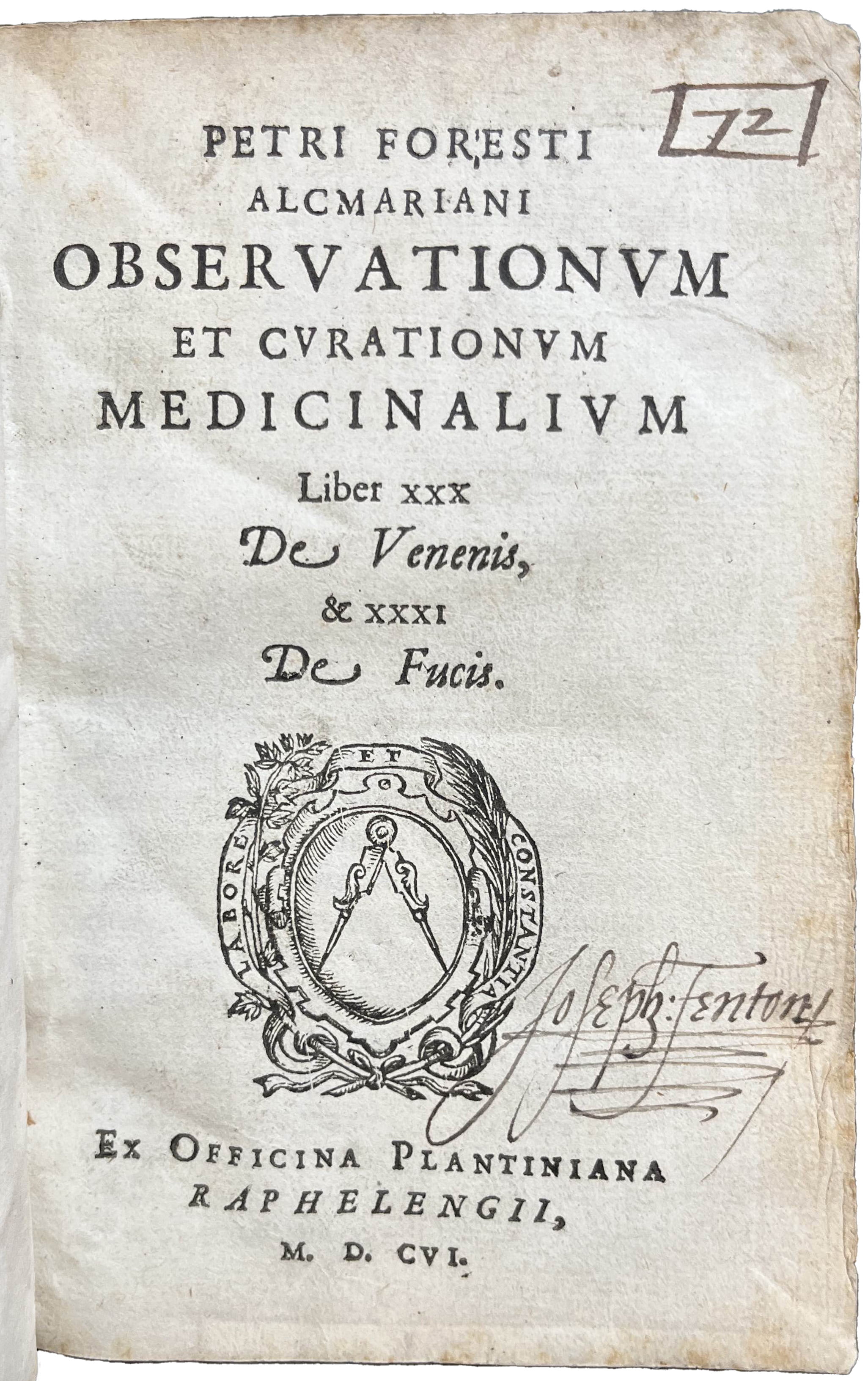FOREEST, Pieter van.
FROM THE LIBRARY OF JOSEPH FENTON
Observationum et curationum medicinalium Liber xxx De Venenis, & xxxi De Fucis.
Leiden, Ex Officina Plantiniana Raphelengii, 1606.£1,750.00
8vo. pp. [8], 236, [12]. Roman letter, with Italic, occasional Greek. Printer’s device to title, decorated initials. Slight browning. A very good copy in contemporary English limp vellum, remains of ties, yapp edges (chewed), small loss at head of spine, armorial bookplate of Edward William Harcourt (1825-91), English naturalist and MP, and C18 ms shelfmarks to front pastedown, ms acquisition note to fly by J.J. Woods dated Oxford, 1951, where he was invited to give a Litchfield lecture in medicine, contemporary ms ‘Joseph Fenton’ and ‘72’ to title, occasional marginal ms marks, 5 lines of ms notes in a C17 English hand to rear pastedown.
From the library of Joseph Fenton (1565-1634), surgeon at St Bartholomew’s Hospital, London, in the same years as William Harvey. ‘Harvey quoted pathological observations made by Fenton in his own notes, and also cites a letter written by John Chamberlain in 1612, regarding the medical treatment of the ailing Robert Cecil, who “hath found most good from the physicians and surgeons of the hospital [St Bartholomew’s], and specially of Fenton”’ (Pearson, p.242). ‘As well as establishing a successful practice in London – he is known to have been highly regarded by senior establishment figures like Cecil and Lancelot Andrewes – he was an active member of the Barber-Surgeons Company’ (BOO). He owned a substantial library of approximately 300 volumes, which he bequeathed to his grandson, the physician (Sir) Joseph Colston (d.1675). It was later dispersed, many books being acquired by Hans Sloane.
Pieter van Foreest (or Petrus Forestus, 1521-97) – known as the ‘Dutch Hippocrates’ – trained at Leuven and Bologna, and became town physician at Delft. In 1584, he was in charge of the autopsy of the recently murdered William III of Orange. His ‘Observationes’, for a total of over 1000 such observations, were based on his everyday practice and experience. They were published 3-4 books at a time, for a total of 32, providing the basis for his ‘Scholia’ or glosses on pathology and treatment. In 1602-9, Plantin printed a collected ed. in separate volumes, with the ‘Scholia’, of which the present – comprising Books 30-31 – is one. The first examines the most common poisons, with copious references to actual cases, from the present or near past, and how they were treated, even providing recipes. Poisons include animal stings or bites (e.g., spiders and bees), arsenic, cantharidin (obtained from the ‘blister beetle’ and used as a remedy), toads, and helleborus. The second work is devoted to skin spots and remedies to preserve beauty generally. Fenton (most likely) highlighted passages on paleness and redness of face. Among the topics discussed are freckles, spots and scares caused by chickenpox and smallpox, the whitening of teeth and hands, and obesity. A very interesting copy.
USTC 1011454; Krivatsy 4199; Wellcome I, 2374 (later ed.); Heirs of Hippocrates 429 (included). Not in Osler. https://bookowners.online/Joseph_Fenton_d.1634; D. Pearson, ‘Illustrations from the Wellcome Library: Joseph Fenton and his Books’, Medical History, 47 (2003), pp.239-48.In stock





